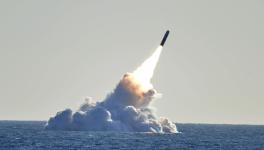Revenue Fall of World’s top 100 Arms Producers Masks Substantial Future Upswing: SIPRI

An Apache AH1 with Hellfire missiles, which are manufactured by Lockheed Martin. | Image courtesy: Flickr
The combined revenues of the world’s top 100 arms and ammunition manufacturing giants, like Lockheed Martin, Raytheon Technologies and Northrop Grumman, increased by a mere 3.5% in 2022. In 2021, it was lesser at 1.9%.
According to the Stockholm International Peace Research Institute’s ‘SIPRI Top 100 Arms-producing and Military Services Companies, 2022, report, the revenues of these companies didn’t rise much despite the rising demand.
The anomaly is explained by labour shortages and supply chain disruptions caused by COVID-19 and rising costs with several American and European firms grappling with the pandemic’s impact.
The total revenue of the 42 United States (US) companies fell by 7.9% to $302 billion. The revenues of top US companies either declined or remained unchanged—Lockheed Martin (ranked No. 1) -8.9%, Raytheon (No. 2) -12%, Boeing (No. 4) -19%, General Dynamics (No. 5) -5.6% and Northrop Grumman (No. 3) and BAE Systems (No. 6) no change.
Similarly, the combined revenue of 26 European companies increased by merely 0.9%. The aggregate revenue of 22 companies in Asia and Oceania rose by only 3.1%.
However, the fall in revenue only “masks a potential substantial upswing in coming years”, the report states. Interestingly, the rising demand predated the Ukraine war. But as the war and the Gaza conflict continue, the demand would rise. Large backlogs and the surging demand would increase revenues in the future.
In an email interview, Dr Nan Tian, acting programme director of SIPRI’s Military Expenditure and Arms Production Programme and one of the report’s co-authors, says as the world recovers from the supply chain disruptions and labour shortages, the revenues would increase as the companies “put these orders through the production process”.
Aninda Dey: Revenues from sales of arms and military services by the top 100 largest companies rose from $592 billion in 2021 to only $597 billion in 2022. But the SIPRI report states that the fall only masks a potential substantial upswing in coming years. Could you elaborate?
Nan Tian: There were large numbers of incoming orders in 2022 that are yet to be processed, manufactured, and delivered. Some of these orders are linked to the war in Ukraine. Once the companies put these orders through the production process, we will see this reflected in their revenues. There is a time lag between when orders are placed and when they are translated into revenue.
AD: The increase in backlogs and orders of companies even predated the Ukraine conflict. Besides, the Russia-Ukraine and Israel-Hamas wars could continue for months. How much growth do you expect companies like MBDA and Saab, which received orders worth $9.5 billion and $6.2 billion in 2022, respectively, to make in the future?
NT: Even though backlogs and orders are common irrespective of the war in Ukraine, the large increase in orders and, in turn, the sharp increase in backlogs is out of the ordinary. Typical companies keep around one to two years of revenue in backlogs.
In 2022, we saw some of these companies' (i.e. Saab) backlogs jump to four to five years of their average revenue. As a result of these backlogs, companies’ revenues will likely increase substantially in the coming years. The caveat is that the companies can supply the orders.
AD: US companies recorded revenues of $304 billion, accounting for 51% of the top 100, despite earnings of American firms falling by 7.9%. Since 2018, the US has been the biggest arms supplier. Isn’t the US fuelling the arms race?
NT: The US has always been the world’s biggest arms producer and exporter. The same was done by Russia before the war by countries such as China, European nations and India. No single country can be argued or put as fuelling the arms race.
Most of the countries mentioned above are spending more on military, procuring more weapon systems and developing a self-sufficient arms industry.
AD: Companies manufacturing specific categories of weapons earned more revenues. Only seven, including Lockheed Martin, Raytheon Technologies and General Dynamics, reported losses. Does that mean companies specialising in specific weapons would make more in the future?
NT: Not necessarily. Revenues of certain companies are likely to fluctuate more than others. In the case of shipbuilders, the finished production and delivery of large ships could see a boost in revenue while years between the start of a building process and the delivery could drop.
In the case of 2022, some of the companies that saw increases in revenues can relate this to the limited impact of supply chain disruptions and labour shortages had on their production line and also if these companies were producing certain types of weapons that were in high demand during the war in Ukraine (i.e. artillery, munitions, etc.)
In addition, the complexity in specific weapon systems, such as those made by some of the largest producers (i.e. Lockheed Martin or Raytheon), is likely to be affected more by supply chain disruption that was still very much a factor in 2022.
AD: On the other hand, revenues of companies making less-advanced military equipment, like Turkey-based Baykar, which manufactures the Bayraktar TB-2 drone, increased by 94%. It was the fastest growth rate of any company in the ranking. Do you see such firms earning more revenues in the future?
NT: These companies will see large fluctuations in their revenues specific to demand and the impact of labour and supply chain issues. It is not the case that companies that make less advanced systems will generate more revenue.
AD: In fact, the largest revenue increase was reported from the Middle East (West Asia) with all seven regional companies—four Turkish and three Israeli—earning a total of $17.9 billion. How much competition can these firms give to their Western counterparts?
NT: In terms of scale, Middle Eastern companies are still much smaller than their Western counterparts. The large percentage increase in the region owes much to only how small their arms sales are.
The companies also serve different markets and essentially different customers. So, the competition that they would give Western counterparts is not large.
AD: What do you think about three Indian firms, whose aggregate revenues increased by 7.4% to $6.4 billion? India wants to be more self-reliant in manufacturing arms. Do you see the share of Indian companies increasing in the future?
NT: The share of Indian companies in the top 100 has not changed much in recent years. The country is still far away from reaching its goal of self-reliance. This goal has taken China over 30 years and hundreds of billions of dollars and it is importing certain combat aircraft engines from Russia.
Orders for equipment used in the war in Ukraine are not really reflected in Indian companies. The companies are also not large exporters. Thus, the demand for Indian weapon systems by other countries is not as large as others. Overall, there is no reason to expect this share to increase in the near future.
AD: Doesn’t it mean arms production in the coming years will shoot up, especially if the present conflicts continue or new ones erupt? Firms making less advanced weapons for which production can be scaled up more easily will compete with companies specialising in specific arms and ammunition.
NT: Based on the rise in demand, production will likely increase in the coming years. Not only firms that make less advanced systems but also other companies. As the world recovers from the supply chain disruptions and labour shortages, the revenue and production of arms companies that were severely affected will also increase.
Get the latest reports & analysis with people's perspective on Protests, movements & deep analytical videos, discussions of the current affairs in your Telegram app. Subscribe to NewsClick's Telegram channel & get Real-Time updates on stories, as they get published on our website.























